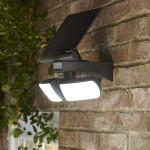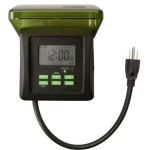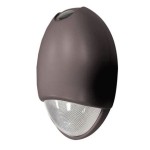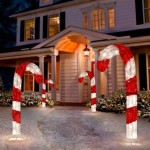Outdoor LED Flood Light Bulbs: A Comprehensive Review
Outdoor LED flood light bulbs have revolutionized exterior lighting, surpassing traditional halogen and incandescent options in energy efficiency, lifespan, and performance. A discerning consumer should consider a variety of factors when selecting the optimal LED flood light for their specific needs. This article delves into a comprehensive review of outdoor LED flood light bulbs, outlining key features, benefits, and considerations for informed decision-making.
Floodlights are essential for illuminating large areas, providing security, and enhancing the aesthetic appeal of properties. They commonly find application in driveways, gardens, patios, walkways, and building facades. The evolution from older lighting technologies to LED has brought significant improvements in energy consumption and light quality. Consequently, understanding the nuances of LED floodlights is crucial for homeowners, contractors, and anyone seeking effective and efficient outdoor illumination.
Key Features and Specifications
Examining the specifications of an LED flood light is paramount before making a purchase. These specifications dictate the bulb's performance and suitability for a given application. Important factors include wattage, lumen output, color temperature, beam angle, and ingress protection (IP) rating.
Wattage and Lumen Output: Wattage indicates the energy consumed by the bulb, while lumen output measures the total amount of visible light emitted. LEDs typically offer a higher lumen output for a lower wattage compared to traditional bulbs, making them more energy-efficient. For example, an LED flood light consuming 20 watts may produce the same amount of light (lumens) as a 100-watt halogen bulb. When selecting a bulb, focus on the lumen output required to adequately illuminate the desired area, rather than solely relying on wattage as an indicator of brightness. Understanding the relationship between wattage and lumen output is critical for selecting an energy-efficient and appropriately bright bulb.
Color Temperature: Color temperature, measured in Kelvin (K), describes the color appearance of the light emitted. Lower Kelvin values (e.g., 2700K-3000K) produce a warm, yellowish light, suitable for creating a cozy and inviting atmosphere. Higher Kelvin values (e.g., 4000K-5000K) produce a cool, white light, which is often preferred for security lighting and areas requiring high visibility. Choosing the right color temperature depends on the intended use and aesthetic preferences. Warm white light is generally preferred for residential gardens and patios, while cool white light is more common for parking lots and security applications. Daylight (5000K-6500K) provides the brightest and most natural-looking light, often used in areas where color accuracy is important.
Beam Angle: The beam angle determines the spread of light emitted by the bulb. A narrow beam angle concentrates the light into a focused area, ideal for spotlighting specific objects or architectural features. A wide beam angle distributes the light over a larger area, suitable for general illumination of driveways or gardens. The appropriate beam angle will depend on the size of the area to be illuminated and the desired effect. A smaller beam angle increases the intensity of the light in a concentrated area, whereas a wider beam angle provides a more diffused and even illumination.
Ingress Protection (IP) Rating: The IP rating indicates the bulb's level of protection against dust and water ingress. An IP65 rating, for example, signifies that the bulb is protected against dust and water jets from any direction, making it suitable for outdoor use. For areas exposed to heavy rain or snow, a higher IP rating, such as IP67 or IP68, may be necessary. Selecting a bulb with an appropriate IP rating is crucial for ensuring its longevity and performance in outdoor environments. Ignoring this specification can lead to premature failure of the bulb due to water damage or dust accumulation.
Beyond these core specifications, other features to consider include dimming capabilities, smart home integration, and the type of LED chip used (e.g., SMD, COB). Dimmable LEDs offer greater control over light intensity, allowing for adjustable brightness levels to suit different needs. Smart home integration enables control of the lights via smartphone apps or voice assistants, offering convenience and energy management features. The type of LED chip affects the bulb's light output, efficiency, and lifespan.
Benefits of LED Flood Lights
The transition from traditional light sources to LED flood lights offers a multitude of benefits, including energy efficiency, extended lifespan, improved light quality, and environmental considerations. These advantages contribute to significant cost savings and a more sustainable lighting solution.
Energy Efficiency: LED flood lights consume significantly less energy compared to halogen and incandescent bulbs. This reduction in energy consumption translates to lower electricity bills and a smaller carbon footprint. LEDs convert a higher percentage of electricity into light, minimizing energy waste in the form of heat. Over the lifespan of an LED bulb, the energy savings can be substantial. Replacing multiple halogen floodlights with LED equivalents can result in a noticeable decrease in energy usage and associated costs.
Extended Lifespan: LED flood lights boast a significantly longer lifespan compared to traditional bulbs. While halogen bulbs may last for 2,000 hours, LEDs can last for 25,000 hours or more. This extended lifespan reduces the frequency of bulb replacements, saving time and money. The longer lifespan also makes LEDs a more practical choice for hard-to-reach areas, where replacing bulbs can be challenging. The reduced maintenance requirements contribute to the overall cost-effectiveness of LED lighting.
Improved Light Quality: LED flood lights offer improved light quality in terms of color rendering, brightness, and uniformity. They provide consistent illumination without flickering or dimming, enhancing visibility and safety. LED technology allows for precise control over color temperature, enabling the selection of the ideal light for different applications. The instant-on capability of LEDs eliminates the warm-up time associated with traditional bulbs, providing immediate illumination when needed. This feature is particularly beneficial for security lighting applications.
Environmental Considerations: LED flood lights are more environmentally friendly than traditional bulbs. They do not contain harmful substances such as mercury, which is found in fluorescent bulbs. LED production and disposal have a smaller environmental impact compared to traditional lighting technologies. The reduced energy consumption of LEDs also contributes to a lower carbon footprint, helping to mitigate climate change. Choosing LED lighting is a step towards a more sustainable and eco-friendly lifestyle.
Beyond these primary benefits, LED flood lights also offer greater durability and resistance to impact. They are less susceptible to damage from vibrations and temperature fluctuations, making them suitable for outdoor use in various weather conditions. The robust construction of LED bulbs ensures reliable performance and longevity.
Considerations When Choosing LED Flood Lights
Selecting the right LED flood light involves careful consideration of several factors, including the intended application, lighting requirements, installation considerations, and budget constraints. Evaluating these factors will ensure that the chosen bulb meets the specific needs and provides optimal performance.
Intended Application: The intended application will significantly influence the selection of LED flood lights. For security lighting, a brighter and more focused light is generally preferred, while for ambient lighting, a softer and more diffused light may be more suitable. Consider the specific purpose of the lighting and choose a bulb that provides the appropriate brightness, color temperature, and beam angle. For example, illuminating a driveway requires a wider beam angle and higher lumen output compared to highlighting a small garden feature.
Lighting Requirements: Evaluate the existing lighting infrastructure and determine the optimal number and placement of floodlights. Consider the size of the area to be illuminated and the desired level of brightness. Conduct a lighting audit to assess the current lighting needs and identify areas where improvements can be made. Consider the presence of any obstructions that may block the light and adjust the placement of the floodlights accordingly. A well-planned lighting system will provide adequate illumination and enhance safety and security.
Installation Considerations: Assess the ease of installation and compatibility with existing fixtures. Ensure that the chosen LED flood light is compatible with the voltage and wiring of the existing electrical system. Consider the need for professional installation, especially for complex wiring or mounting requirements. Check for any local building codes or regulations that may apply to outdoor lighting installations. Proper installation is crucial for ensuring the safe and reliable operation of the floodlights.
Budget Constraints: LED flood lights may have a higher initial cost compared to traditional bulbs. However, the long-term cost savings from energy efficiency and reduced maintenance should be factored into the decision-making process. Evaluate the total cost of ownership, including the initial purchase price, energy consumption, and replacement costs. Consider the payback period, which is the time it takes for the energy savings to offset the initial cost of the LED flood lights. Investing in high-quality LED flood lights will ultimately provide better value and performance over the long term.
Beyond these core considerations, also consider the warranty offered by the manufacturer. A longer warranty period indicates the manufacturer's confidence in the quality and durability of their product. Read online reviews and compare different brands and models to gather valuable insights from other users. Choosing a reputable brand with a proven track record of performance is essential for ensuring customer satisfaction.
In summary, selecting the optimal outdoor LED flood light bulb requires a thorough understanding of key features, benefits, and considerations. By carefully evaluating wattage, lumen output, color temperature, beam angle, IP rating, intended application, lighting requirements, installation considerations, and budget constraints, consumers can make informed decisions that result in efficient, effective, and long-lasting outdoor lighting solutions.

Led Flood Lights What You Need To Know

Led Flood Lights What You Need To Know

Reviews For Ecosmart 325 Watt Equivalent Par38 Dimmable Flood Led Light Bulb With Selectable Color Temperature 1 Pack Pg The Home Depot

Reviews For Feit Electric 120 Watt Equivalent Par38 Outdoor Dimmable Cec Title 20 90 Cri E26 Medium Base Flood Led Light Bulb Daylight 5000k Pg 1 The Home Depot

Best Led Floodlight Bulbs Of 2024 Cnet

Led Flood Lights What You Need To Know

Reviews For Feit Electric 75 Watt Equivalent Par38 Non Dimmable Cec Title 20 Outdoor 90 Cri E26 Flood Led Light Bulb Daylight 5000k 4 Pack Pg 1 The Home Depot

Customer Reviews Unbranded Br30 Outdoor Smartbulb 1000 Lumens 15w Dimmable Led Floodlight Bulb 75w Equivalent Arctic White Mlbr302o Best Buy

Ge Led Motion 90 Watt Eq Par38 Warm White Medium Base E 26 Light Bulb In The Spot Flood Bulbs Department At Com

The 3 Best Smart Outdoor Lights For Backyards Of 2024 Reviews By Wirecutter
Related Posts







